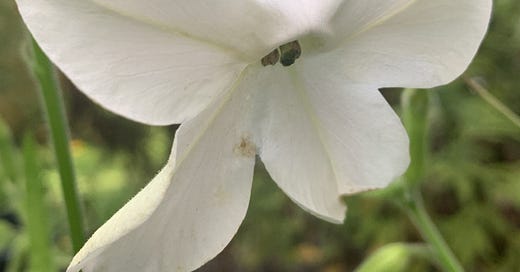Jasmine Tobacco essence helps us to restructure our relationship with the addiction pattern we humans tend to have. An understanding of the patterns and cycles of addiction will help us to understand Jasmine Tobacco essence, ourselves, and the people in our lives.
The short version:
The addiction pattern is one in which we (usually unconsciously) seek to fill an emptiness or inherent dissatisfaction inside of us with a behavior or substance that alters our experience to give us temporary relief from the pain of the emptiness. It is, essentially, a refusal to be with our emptiness; with ourselves.
Since it doesn't solve the problem, we keep returning to our state of emptiness or dissatisfaction and then to the temporary or false distraction or satisfaction, and back to the emptiness, over and over again. The behaviors or substances we turn to tend to be harmful or at least not helpful/healthy in the long run. Staying within the cycle will never get us out of it. There has to be a break away from our pattern, an understanding of its nature, and consistent redirection when the pattern presents itself as an option, until we’ve created newer habits that are healthy and honoring of the whole of us.
More about this:
Many humans have a tendency towards addiction. We come to this world forgetting our sacredness and our unity with all that is, so we have an original wound of separation. And then depending on our upbringing, we either find our unity, clarity and confidence through our experiences, or we keep piling on the wounds in confusion — hopefully also acquiring some lovely and soul-affirming experiences, too.
But eventually, we see how our wounds, big or small, effect the way we move through life. And for some of us, that means we discover where we are acting in ways that are confounding to our logical brains. Why do I keep ___________?
And if we're interested in taking responsibility for it, we look to see where, when, and why that behavior might have developed. Bringing healing to the original wound can happen in many ways. Sometimes it’s as simple as acknowledgement, acceptance, and moving through the emotions we suppressed. Sometimes it’s a more complex web of retribution. But when we tend to those original wounds and the feelings that live in our body as a result, we are able to have a different experience now.
Along the way, it's tempting to try to make ourselves feel better without having to do the work, and that is usually where our addictive behaviors develop.
I'll present two different ways to think about addiction.
1. I like it, I want more, and my logical discernment does not override this impulse.
We experience something good and want more, so we keep engaging to keep getting more. This can happen on a physical level like the dopamine hit we get from engagement on social media making our brain crave more, or sugar creating a reaction in our bodies that makes us keep wanting more sugar. Even experiences that seem psychological or emotional, like having an experience of connection or ecstasy and wanting to continue bringing it about, is still happening on a physical level as the body desires more the hormones that were created during the experience. There are really endless examples of how this can happen on the level of the physical and beyond. But from this perspective, the reason for the addiction is the original input and our body's desire for more.
2. What can I do to feel more whole and at peace, to avoid being with this empty feeling inside me?
We are always looking for something to heal our original wound of separation. We are always looking for something to make us feel whole, complete, at peace.
Perhaps that comes through attention, connection, validation from others; the excitement of believing this one is "the one," or believing another person makes you whole or okay. This is known as love addiction.
Perhaps it comes through the physical-emotional-chemical experience of sexual encounter, or the validation that comes from someone accepting you in the vulnerability of nakedness. This is known as sex addiction.
Perhaps it comes through the pleasure and sensation of eating a chocolate chip cookie, a crispy, salty snack, or the satiating sensation of giving yourself that food you desire, and desiring it because of the feeling you anticipate it will give you. This is known as food addiction.
Perhaps it comes through the relief of escaping the way your brain has been feeling by having a drink, a smoke, a snort of something that alters the way you feel. This is known as substance addiction.
In my experience, all addiction, including the ability to become addicted to an external substance or a behavior as illustrated in #1 (the physical pattern), stems from #2 (an internal emptiness that wants to be filled.)
If we are experiencing an addiction and our sound, logical discernment doesn't keep us from engaging with the addiction cycle, it's because there is something within us that feels inherently off. We have a hole inside us that remains empty no matter what we try to fill it with. We receive momentary relief through the sensations of our addictions, but the problem is never solved by them. We will continue to cycle through feeling empty, trying to satiate that emptiness, and feeling empty again. The momentary satiation is what keeps us going back for more.
Most people I interact with struggle with this in some way, shape or form. I also know people who don't appear to. We all come to this earth with things to learn and overcome, and we're not all struggling with the same challenges. The addiction pattern is common, but it can be overcome. And if it isn't something you struggle with, I hope this can help you to understand the people in your life who struggle with these patterns. Either way, Jasmine Tobacco can help.




